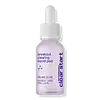What's inside
What's inside
 Key Ingredients
Key Ingredients

 Benefits
Benefits

 Concerns
Concerns

 Ingredients Side-by-side
Ingredients Side-by-side

Water
Skin ConditioningGlycolic Acid
BufferingSodium Citrate
BufferingPropanediol
SolventButylene Glycol
HumectantHydroxyethylcellulose
Emulsion StabilisingAgave Tequilana Leaf Extract
AstringentAllantoin
Skin ConditioningAloe Barbadensis Flower Extract
EmollientCamellia Sinensis Leaf Extract
AntimicrobialCentella Asiatica Extract
CleansingChamomilla Recutita Flower Extract
MaskingChlorphenesin
AntimicrobialCoccinia Indica Fruit Extract
Skin ConditioningCorallina Officinalis Extract
Skin ConditioningCurcuma Longa Root Extract
Masking1,2-Hexanediol
Skin ConditioningEthylhexylglycerin
Skin ConditioningGlyceryl Caprylate
EmollientGlycyrrhiza Glabra Root Extract
BleachingHydrolyzed Hyaluronic Acid
HumectantMelia Azadirachta Flower Extract
Skin ConditioningMelia Azadirachta Leaf Extract
Skin ConditioningOcimum Sanctum Leaf Extract
Skin ConditioningPanthenol
Skin ConditioningPantolactone
HumectantPhenoxyethanol
PreservativePolygonum Cuspidatum Root Extract
AntioxidantRosmarinus Officinalis Leaf Extract
AntimicrobialSalicylic Acid
MaskingScutellaria Baicalensis Root Extract
AstringentSodium Acetylated Hyaluronate
HumectantSodium Hyaluronate
HumectantSolanum Melongena Fruit Extract
Skin ConditioningTrisodium Ethylenediamine Disuccinate
Xanthan Gum
EmulsifyingPolyglyceryl-10 Caprylate/Caprate
EmulsifyingPolyglyceryl-10 Laurate
Skin ConditioningLavandula Angustifolia Oil
MaskingPelargonium Graveolens Flower Oil
MaskingWater, Glycolic Acid, Sodium Citrate, Propanediol, Butylene Glycol, Hydroxyethylcellulose, Agave Tequilana Leaf Extract, Allantoin, Aloe Barbadensis Flower Extract, Camellia Sinensis Leaf Extract, Centella Asiatica Extract, Chamomilla Recutita Flower Extract, Chlorphenesin, Coccinia Indica Fruit Extract, Corallina Officinalis Extract, Curcuma Longa Root Extract, 1,2-Hexanediol, Ethylhexylglycerin, Glyceryl Caprylate, Glycyrrhiza Glabra Root Extract, Hydrolyzed Hyaluronic Acid, Melia Azadirachta Flower Extract, Melia Azadirachta Leaf Extract, Ocimum Sanctum Leaf Extract, Panthenol, Pantolactone, Phenoxyethanol, Polygonum Cuspidatum Root Extract, Rosmarinus Officinalis Leaf Extract, Salicylic Acid, Scutellaria Baicalensis Root Extract, Sodium Acetylated Hyaluronate, Sodium Hyaluronate, Solanum Melongena Fruit Extract, Trisodium Ethylenediamine Disuccinate, Xanthan Gum, Polyglyceryl-10 Caprylate/Caprate, Polyglyceryl-10 Laurate, Lavandula Angustifolia Oil, Pelargonium Graveolens Flower Oil
Water
Skin ConditioningPropanediol
SolventLactic Acid
BufferingGlycerin
HumectantSodium Hydroxide
BufferingSalicylic Acid
MaskingCoco-Caprylate/Caprate
EmollientPentylene Glycol
Skin ConditioningSodium Polyacryloyldimethyl Taurate
Emulsion StabilisingXanthan Gum
EmulsifyingCellulose Gum
Emulsion StabilisingPhenethyl Alcohol
MaskingAzelaic Acid
BufferingMandelic Acid
AntimicrobialCalcium Sodium Borosilicate
Melia Azadirachta Flower Extract
Skin ConditioningSilica
AbrasiveCoccinia Indica Fruit Extract
Skin ConditioningCI 77891
Cosmetic ColorantSodium Carbonate
BufferingSodium Chloride
MaskingWater, Propanediol, Lactic Acid, Glycerin, Sodium Hydroxide, Salicylic Acid, Coco-Caprylate/Caprate, Pentylene Glycol, Sodium Polyacryloyldimethyl Taurate, Xanthan Gum, Cellulose Gum, Phenethyl Alcohol, Azelaic Acid, Mandelic Acid, Calcium Sodium Borosilicate, Melia Azadirachta Flower Extract, Silica, Coccinia Indica Fruit Extract, CI 77891, Sodium Carbonate, Sodium Chloride
 Reviews
Reviews

Ingredients Explained
These ingredients are found in both products.
Ingredients higher up in an ingredient list are typically present in a larger amount.
Coccinia Indica Fruit Extract is also known as Ivy Gourd Fruit Extract. It has skin conditioning properties.
Melia Azadirachta Flower Extract is from the Neem tree. Neem trees originate from India.
Melia Azadirachta Flower Extract contains antioxidants. Antioxidants help fight free-radicals. Free-radicals are molecules that may damage your skin cells, such as pollution.
The flowers of this tree are lilac colored.
Learn more about Melia Azadirachta Flower ExtractPropanediol is an all-star ingredient. It softens, hydrates, and smooths the skin.
It’s often used to:
Propanediol is not likely to cause sensitivity and considered safe to use. It is derived from corn or petroleum with a clear color and no scent.
Learn more about PropanediolSalicylic Acid (also known as beta hydroxy acid or BHA) is a well-known ingredient for treating skin that struggles with acne and clogged pores. It exfoliates both the skin's surface and deep within the pores to help clear out buildup, control oil, and reduce inflammation.
Unlike AHAs (alpha hydroxy acids), salicylic acid is oil-soluble. This allows it to penetrate into pores which makes it especially effective for treating blackheads and preventing future breakouts.
Salicylic acid is also known for its soothing properties. It has a similar structure to aspirin and can calm inflamed or irritated skin, making it a good option for acne-prone skin that is also sensitive.
Concentrations of 0.5-2% are recognized by the U.S. FDA as an over-the-counter topical acne product.
It can cause irritation and/or dryness if one's skin already has a compromised moisture barrier, so it's best to focus on repairing that before introducing this ingredient into your routine.
While salicylic acid does not increase sun sensitivity, it’s still important to wear sunscreen daily to protect your skin.
If you are looking for the ingredient called BHA or Butylated Hydroxyanisole, click here.
Learn more about Salicylic AcidWater. It's the most common cosmetic ingredient of all. You'll usually see it at the top of ingredient lists, meaning that it makes up the largest part of the product.
So why is it so popular? Water most often acts as a solvent - this means that it helps dissolve other ingredients into the formulation.
You'll also recognize water as that liquid we all need to stay alive. If you see this, drink a glass of water. Stay hydrated!
Learn more about WaterXanthan gum is used as a stabilizer and thickener within cosmetic products. It helps give products a sticky, thick feeling - preventing them from being too runny.
On the technical side of things, xanthan gum is a polysaccharide - a combination consisting of multiple sugar molecules bonded together.
Xanthan gum is a pretty common and great ingredient. It is a natural, non-toxic, non-irritating ingredient that is also commonly used in food products.
Learn more about Xanthan Gum